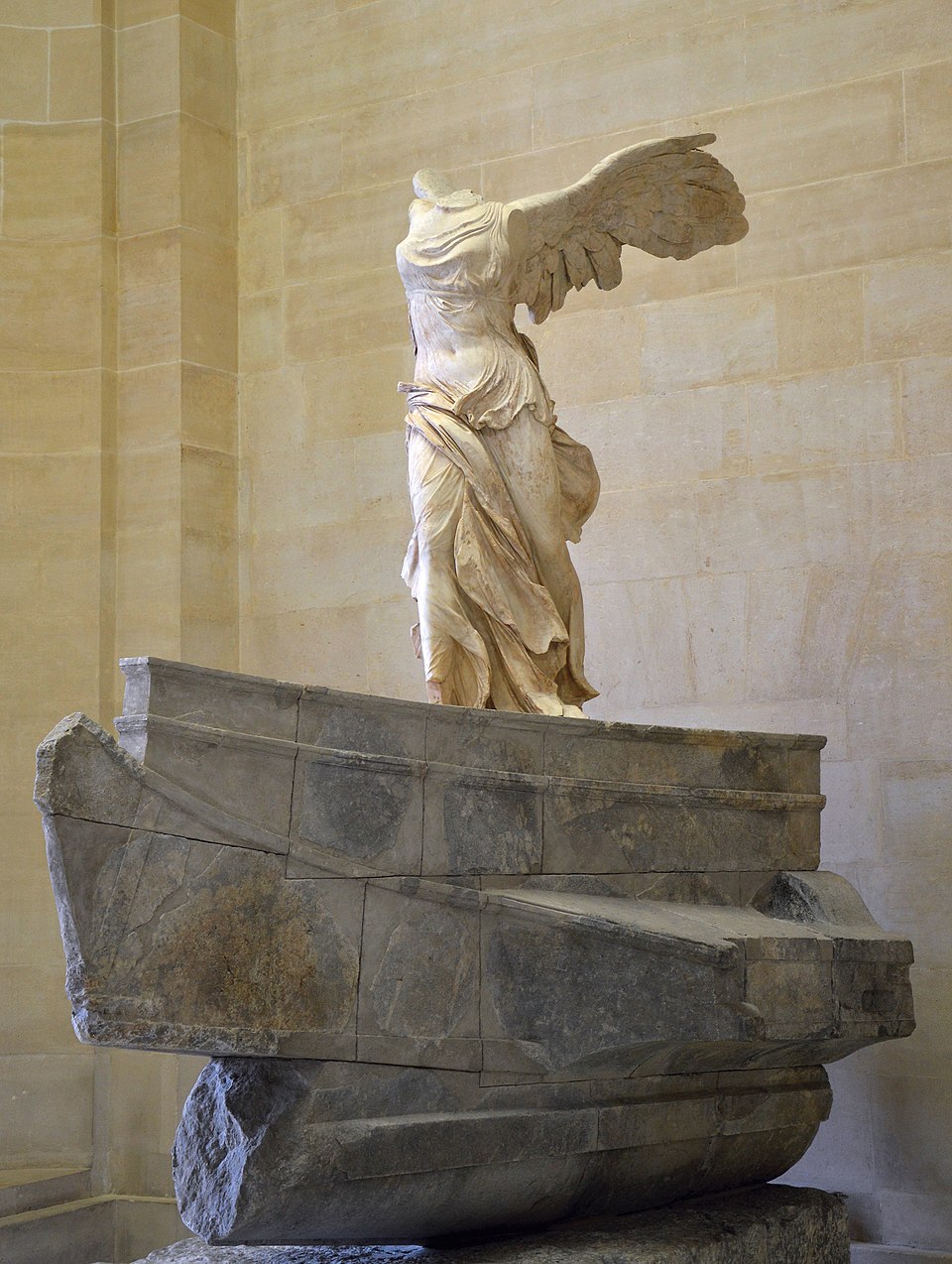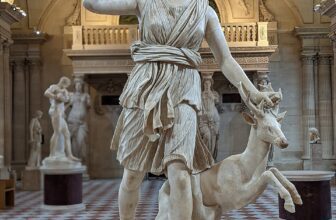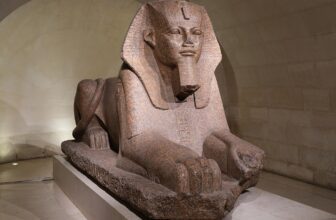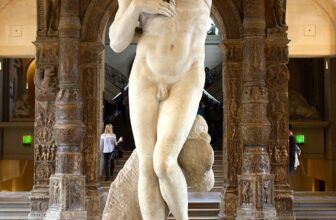
The Goddess Who Defied Time: The Story of Nike in the Louvre
In the hushed grandeur of the Louvre Museum in Paris, as sunlight trickles down marble staircases and echoes of footsteps float between ancient stone, there stands a sculpture that has enthralled the world for centuries. Perched atop the Daru staircase, poised as if caught mid-flight, the Nike of Samothrace, also called the Winged Victory of Samothrace, stands not just as a masterpiece of ancient art, but as a symbol of triumph, resilience, and divine grace. But who is she? Why is she called the Goddess of Victory? And what secrets does this headless, armless, and yet overwhelmingly powerful figure still hold? Deep dive into the iconic sculpture known as the Nike of Samothrace, often called the Winged Victory, and the fascinating history, symbolism, and cultural significance that surround it.
The Birth of Victory: Who is Nike?
To the ancient Greeks, Nike was more than just a name, it was the divine embodiment of victory itself. In mythology, Nike was the daughter of the Titan Pallas and the goddess Styx. She was often depicted with wings, flying across battlefields and athletic arenas, bestowing glory upon the victors. Unlike other gods who governed vast domains of nature or human life, Nike was precise in her purpose: she represented the moment of triumph, the exultation of winning, the sacred instance when struggle meets success.
Nike was often seen accompanying the mighty Zeus or Athena in battle. Her presence was not passive; she was a divine acknowledgment that victory had been earned, either in war or competition. To win was to be touched by Nike.
It’s no coincidence that the modern athletic brand Nike borrowed her name, it’s a nod to aspiration, speed, endurance, and above all, victory.
Why Is the Nike in the Louvre Called the “Goddess of Victory”
The statue that graces the Louvre today, known as the Nike of Samothrace, isn’t just a representation of the goddess, it’s a celebration of victory itself. Created around 190 BCE, likely to commemorate a naval triumph, this sculpture was meant to be both a religious offering and a powerful visual message.
The statue doesn’t merely show Nike standing; she appears to be landing on the prow of a ship, her wings still outstretched from flight, robes clinging to her body as if winds still rage around her. This sense of motion, this captured energy, is rare in sculpture, even rarer in works over 2,000 years old. To behold her is to witness the divine moment when the heavens touch the earth, when victory descends upon the mortal realm.
She is called the Goddess of Victory because she is quite literally that. Not just in name or myth, but in physical form: Nike, the goddess, frozen in marble, alighting on a warship’s bow with power, grace, and an almost defiant elegance.
Why Is Winged Victory Famous
Art historians, poets, generals, and ordinary visitors alike have been drawn to the Winged Victory of Samothrace for more than a century. Her fame doesn’t rest solely on her age or beauty, though she has both in abundance, but on how she makes people feel.
She is incomplete. Her head is gone. Her arms, too. Time has ravaged her body, but her spirit remains untouched. In fact, the very absence of her head makes her all the more powerful. She doesn’t demand attention through a gaze or expression. Instead, she radiates emotion through posture, movement, and sheer presence. The windswept drapery clings and billows like sails on a ship; the wings, spread high, seem ready to take flight again. This is motion captured in marble, not static but alive.
The statue is also technically brilliant. Created in the Hellenistic period, a time when Greek sculpture evolved to capture more emotion, realism, and drama, the Nike of Samothrace embodies all three. The mastery of how the marble mimics wet cloth and dynamic movement reveals the high level of artistry achieved by ancient Greek sculptors.
It’s more than just a statue. It’s a feeling made stone, a visceral, emotional tribute to triumph against the odds. And that’s why she’s famous.
Where Is the Nike of Samothrace Now
Today, the Winged Victory of Samothrace resides in one of the world’s most renowned museums: the Louvre Museum in Paris, France. She stands at the top of the Daru staircase, greeting millions of visitors each year as they ascend toward her with reverent awe.
But she wasn’t always in Paris. The statue was discovered in 1863 by French archaeologist Charles Champoiseau on the island of Samothrace, located in the northern Aegean Sea. Samothrace was once home to a powerful sanctuary dedicated to the Great Gods (known as the Kabeiroi), a secretive cult that honored mystery, protection, and the divine. Nike was likely erected there as a naval offering to commemorate a victory, possibly by the Rhodians over Antiochus III in the early 2nd century BCE.
After her discovery, fragments of the statue were transported to France. Over the decades, additional pieces, including her right wing (which is a mirror-image plaster cast of the left one), parts of her robes, and the base resembling a ship’s prow, were added as they were found or reconstructed. Her head, however, has never been recovered.
Now, in the Louvre, she stands elevated on a marble ship’s prow, as if still catching the Aegean winds that once surrounded her on Samothrace.
Did the Winged Victory of Samothrace Have a Head
Yes, at some point, the statue did have a head. But that part of her body, along with her arms, was lost to time, damage, and burial. Since her discovery, no definitive match for the head has ever been found, though many have searched and speculated.
Interestingly, it’s this absence that gives the sculpture such mythic power. Without a face to tell us what she was feeling, we project our own emotions onto her. She is triumphant, sorrowful, proud, exhausted, radiant, all at once.
Art historians have long debated whether a restoration of her head would enhance or diminish her power. Most agree: her faceless form is, paradoxically, what makes her most human and divine.
Efforts to find her missing pieces continue. Fragments of fingers and hands believed to belong to the statue were uncovered near Samothrace, including a hand displayed nearby in the Louvre. These pieces help to flesh out the image of what she might have looked like, perhaps raising one arm in proclamation or offering, but the mystery remains part of her legacy.
Is Winged Victory Greek or Roman?
The Nike of Samothrace is distinctly Greek, a product of the Hellenistic era, which followed the conquests of Alexander the Great and stretched from around 323 BCE to 31 BCE. This period saw Greek art push boundaries, embracing emotional expression, dynamic movement, and dramatic realism in sculpture.
While the Romans were later great admirers and imitators of Greek art, copying and adapting many works, the Winged Victory was not Roman in origin. She belongs squarely in the tradition of Greek artistic and religious culture.
That said, the Romans did adopt the goddess Nike into their own mythology, where she was known as Victoria. Much like her Greek counterpart, Victoria was honored as the personification of victory and was often depicted in similar fashion, winged and full of grace. You can see her likeness on Roman coins, triumphal arches, and temple friezes.
But the Nike of Samothrace is Greek to the core: a product of seafaring, sculpture, religion, and war, melded into a divine symbol that has transcended its time.
Nike’s Legacy: A Goddess for the Modern Age
In many ways, the Winged Victory has become more than just a relic of ancient Greece. She is a muse, inspiring everything from fashion to philosophy.
Her influence appears in high fashion, cinematic imagery, literature, and of course, in the logo of Nike, Inc., the global sports brand that adopted her name and used the idea of swift, victorious movement as the foundation for its identity. The swoosh is a simplified abstraction of her wing.
But her deeper legacy is about resilience.
Here stands a statue who has lost her head, her arms, and yet commands more awe than most intact works. Incomplete yet invincible, she reminds us that victory is not about perfection. It is about the will to rise, the beauty in motion, the grace in effort.
As visitors from around the world stand before her in the Louvre, phones forgotten in hands, they feel what the ancient Greeks must have felt, that fleeting, eternal brush with something greater. A goddess of victory not made to be worshipped, but to be remembered, revered, and reimagined with every generation.
In the end, the Nike of Samothrace doesn’t need a head to speak, nor arms to embrace. She speaks through the silence, through the marble folds of her robe, through the invisible winds that still blow across her wings.
She is Victory, not just of war or competition, but of art, of time, of the human spirit.




